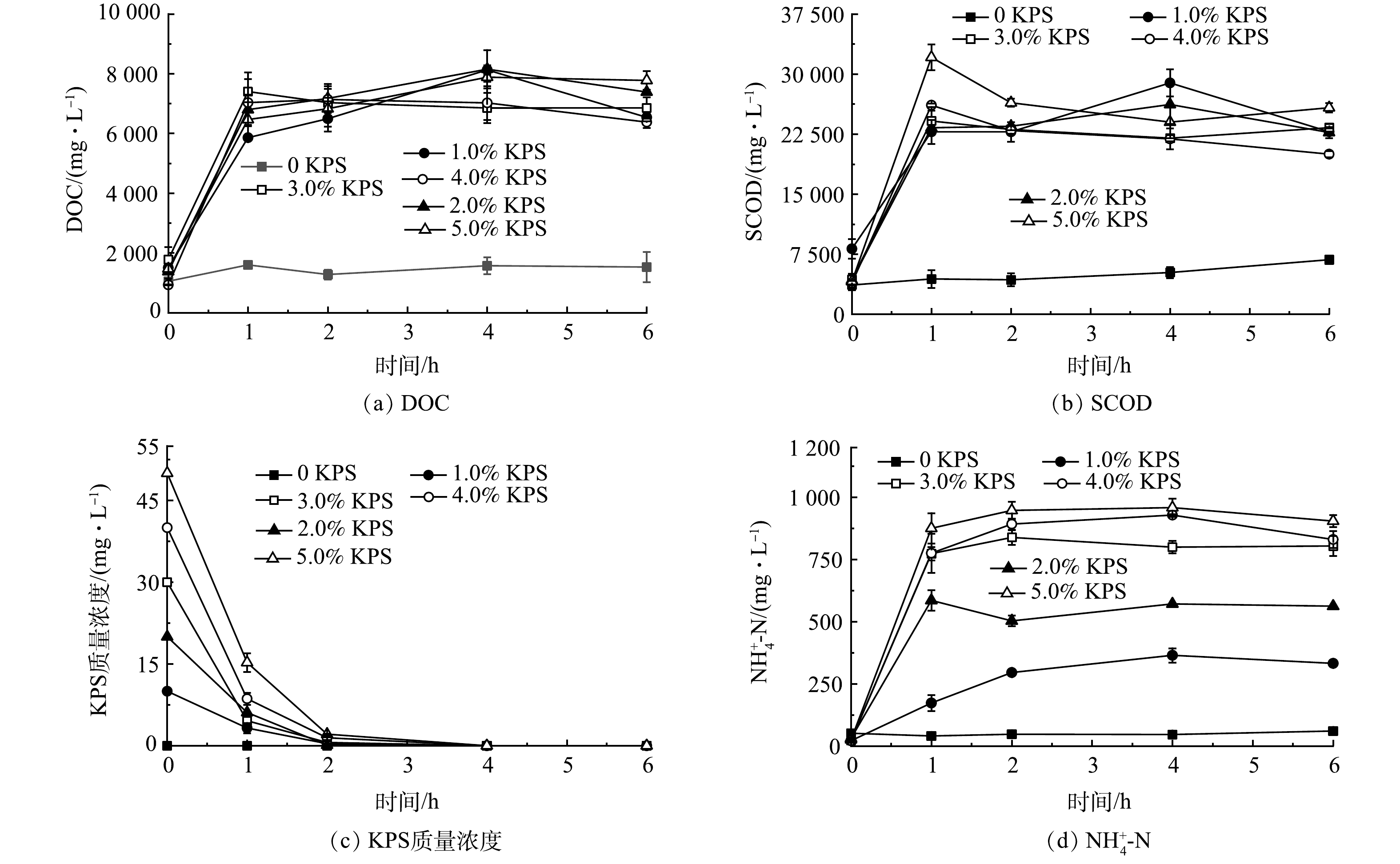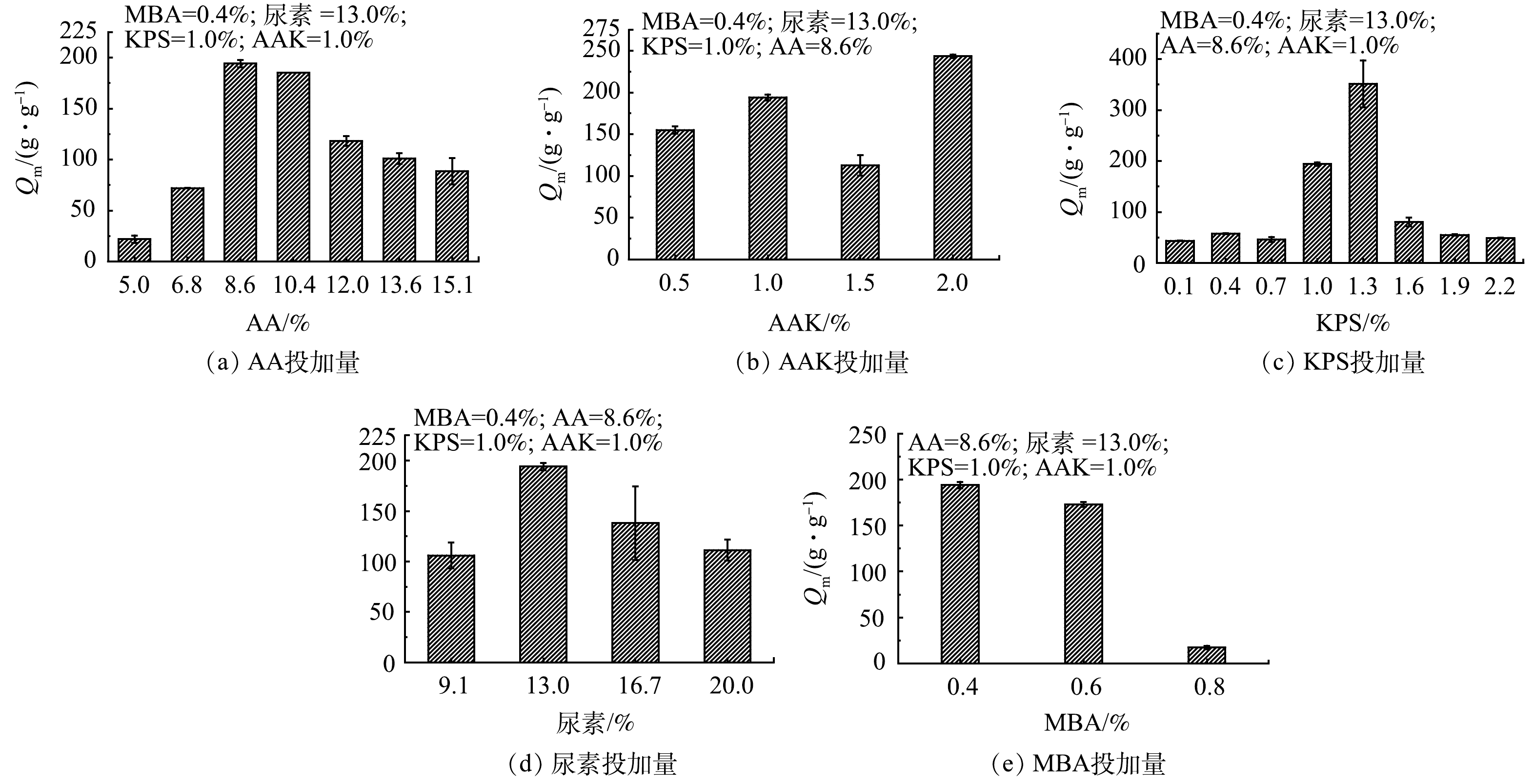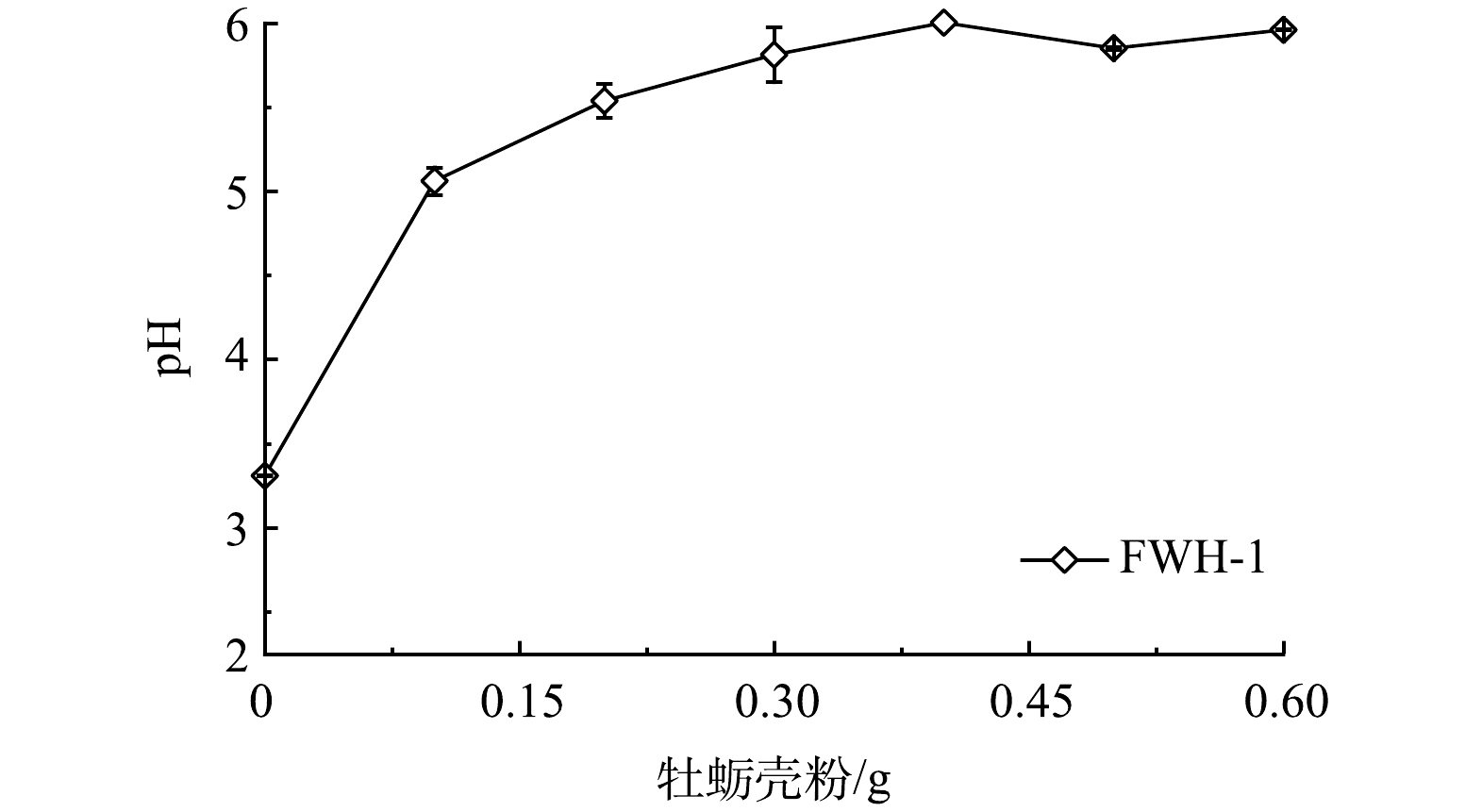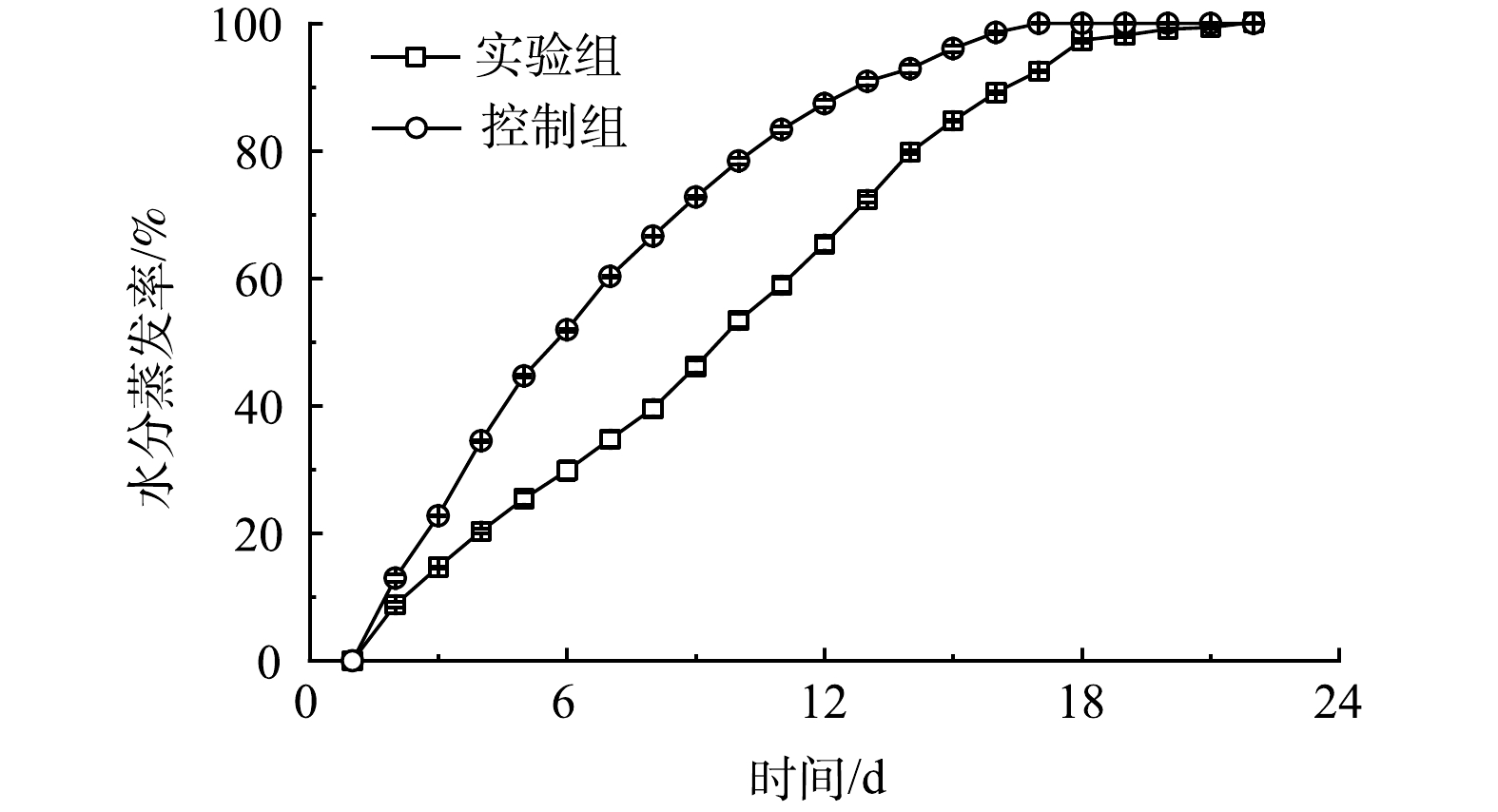-
2020年我国城市生活垃圾清运量已高达2.35×108 t,其中餐厨垃圾约占生活垃圾总量的60%以上[1]。餐厨垃圾具有高有机质、高含水率、易腐败变质等特点,其资源化利用是我国全面推进垃圾分类的关键技术堵点[1]。根据国务院办公厅发布的《“无废城市”建设试点工作方案》[2],我国鼓励固体废物的充分资源化利用,并明确要求促进餐厨垃圾资源化,拓宽产品出路。如好氧堆肥和厌氧消化等生物转化方法,可通过较长的腐殖质化周期 (30~60 d) 将餐厨垃圾转化为相对稳定的腐殖质物质 (肥料) 或沼气 (60%~70% CH4,30%~40% CO2) 等产品[3]。然而,餐厨垃圾的高含水率、C/N不平衡、腐殖化过程营养元素流失严重等特性[4]制约了其好氧堆肥的发展。餐厨垃圾的高蛋白特性使其在厌氧消化过程中极易遭遇氨抑制,容易造成厌氧消化的失稳[5]。近年来,研究者一直在寻求餐厨垃圾的资源化利用新途径,如提取生物降解塑料技术、生物柴油技术等[6]。其中,将餐厨垃圾制成水凝胶是一种具有前景的资源化利用新方式。
水凝胶是一种亲水性、不溶性交联聚合物,具有较高的溶胀能力,可在三维网状网络中吸收大量的水溶液[7],广泛用于农业、园艺和水处理等领域[8]。餐厨垃圾含有丰富的-COOH、-OH、C=C等特征官能团,可通过聚合反应转化为具有三维网络结构的水凝胶。淀粉基、纤维素基、木质素基和多糖基等水凝胶具有良好的生物相容性和生物可降解性,因此相关研究备受关注[8-10]。如以木屑为原料,尿素作为氮源,采用过硫酸钾和N,N'-亚甲基双丙烯酰胺分别作为引发剂和交联剂,可通过接枝共聚法制备出最大含水率210 g·g−1的吸水性水凝胶缓释氮肥[11]。以米饭粉末为底物、N,N'-亚甲基双丙烯酰胺为交联剂、过硫酸盐为引发剂、丙烯酸为单体,同样可合成具有优越吸水性能 (102.6 g·g−1) 和缓释性能的凝胶基缓释氮肥[12]。作为底物制备水凝胶时,采用混合餐厨垃圾比单独的剩余米饭更具有吸引力,因为其具有更丰富的特征官能团。
本研究以混合餐厨垃圾为底物,引入热/过硫酸盐系统对餐厨垃圾浆液进行预处理,以预处理后的浆液合成餐厨垃圾凝胶基缓释氮肥。拟探究单体、引发剂、交联剂和调控剂投加量对水凝胶样品吸水率的影响,以确定最优的聚合交联工艺参数,对生成的水凝胶进行了微观表征,并对水凝胶的膨胀行为能力和pH释放行为开展研究。通过餐厨垃圾水凝胶与牡蛎壳粉复配制备出凝胶基缓释氮肥,并对其缓释氮的能力和在土壤中的保水性能进行综合评价。
-
实验采用的餐厨垃圾由米饭、白菜、猪肉和豆腐按照湿基质量比35%、45%、16%和4%配成[13],于4°C 冰箱保存备用。4种组分来自安徽省黄山市当地菜市场,均经过煮熟处理。将餐厨垃圾和纯水按重量比1∶5混合后,用破碎搅拌机 (M1,智掂科技 (深圳) 有限公司,中国) 将其粉碎浆化后得到餐厨垃圾浆液。牡蛎壳粉采集自安徽省黄山市当地菜市场,经干燥研磨后过300目筛备用。实验所用试剂主要有:丙烯酸钾 (potassium acrylate,AAK,≥95.0%) 、N,N'-亚甲基双丙烯酰胺 (N,N,-methylenebis (acrylamide),MBA,AR级) 、尿素 (≥99.0%) 、过硫酸钾 (potassium persulfate,KPS,AR级) 和丙烯酸 (acrylic acid,AA,≥98.0%)。
-
1) 餐厨垃圾预处理。向250 mL锥形瓶中加入100 mL餐厨垃圾浆液,再分别加入不同剂量 (0~5.0%) 的KPS,充分混合后放入水浴锅内 (HH-6J,常州恩培仪器制造有限公司,中国) ,在80°C条件下水浴加热,并以300 r·min−1磁力搅拌。在0、1、2、4、6 h分别取出餐厨垃圾浆液,离心20 min后 (TDZ5-WS,上海卢湘仪离心机仪器有限公司,中国) ,取上层清液用于溶解性有机碳 (DOC) 、溶解性化学需氧量 (SCOD) 、NH4+-N和KPS质量浓度的测定。
2) 餐厨垃圾水凝胶(food waste hydrogel, FWH)的制备。将预处理后的浆液装入250 mL锥形瓶中,在水浴锅内70°C条件下加入AA、AAK、KPS、MBA和尿素,在搅拌条件下反应15 min生成水凝胶后,取出并用乙醇、纯水各洗涤3遍后真空烘干 (KH-45A,广州市康恒仪器有限公司,中国) 备用。
3) 凝胶基缓释氮肥的制备。将牡蛎壳粉和FWH按一定质量比 (1∶20~12∶20) 混合均匀后,加入适量纯水,反应30 min后干燥,得到餐厨垃圾凝胶基缓释氮肥 (FWH-oyster shell powder,FWH-OSP) 。
-
1) 膨胀行为能力测试。吸水能力测定:选取干燥块状样品0.5 g置于盛有150 mL去离子水中,室温下 (25~30°C) 静置吸水,直至吸水平衡,用滤纸拭去吸水凝胶表面水分后连续称重至测量之差 ≤ 0.05 g。水凝胶最大溶胀率Qm (即最大吸水率,单位g·g−1) 测定,如式(1)所示。
式中:W0 和W1 分别为干燥和吸水平衡后的凝胶质量,g。
水凝胶溶胀动力学测试。选取0.5 g 干燥粉末于 200 目尼龙袋中,浸入 150 mL 去离子水和 0.10 mol·L−1 NaCl、CaCl2 和 AlCl3 溶液中。不同时间取出尼龙袋,用吸水纸拭去表面溶液后称重记录。该溶胀动力学采用Schott's的二级动力学模型进行模拟[14],如式(2)所示。
式中:Qt和Q∞为某时刻的吸水溶胀率和最大溶胀率,g·g−1;为Kis是最初的溶胀速率常数,g·g−1·s。
2) 表征方法。采用傅立叶变换红外 (FT-IR) 光谱分析仪 (Nicolet 380,赛默飞世尔科技公司,美国) 、冷场扫描电子显微镜 (Hitachi Regulus 8230,日立科学仪器有限公司,北京) 和热重分析仪 (Netzsch Sta449,耐驰仪器制造有限公司,德国) 对凝胶样品进行特征官能团、表面形貌和热重分析。其中热重分析的实验过程中采用的热解气氛为纯度大于99.999%的氮气。
3) 水质指标测定。COD、NH4+-N和TN采用水质分析仪 (GL-900,格林凯瑞精密仪器有限公司,中国) 检测[15]。DOC采用TOC仪 (Model 1030W,OI公司,美国) 检测,检测前将10 mL样品通过0.45 μm的水相滤膜过滤。pH通过pH计 (S700,梅特勒-托利多集团,瑞士) 测定,取0.5 g样品于 150 mL 烧杯中,添加 100 mL 纯水或盐溶液。烧杯于实验室常温下静置为静态pH释放测定,烧杯于水浴恒温振荡器 (THZ-82A,绍兴市苏珀仪器有限公司,中国) 中 (25 ℃,150 r·min−1) 为动态下pH释放测定。
4) 凝胶基缓释氮肥的特性分析。FWH-OSP的氮浸出行为分析参考ZHOU等[12]报导的方法,计算滤液体积和测定滤液中TN含量。氮浸出损失率 (Leaching loss ratio,LLR) 通过式(3)计算。
LLR = TN浸出损失量 / TN×100% (3)
5) 土壤中的保水性能测试。凝胶基缓释氮肥持水性能研究参考文献[16]:田间土为筛下土 (过100目筛网) 。1.0 g凝胶基缓释氮肥样品混合40 g田间土后装填于50 mL塑料离心管中,称重,记为W0;然后缓慢淋入20 mL纯水,称重,重量记为W1;敞口至于实验室避光处,每天称重,记为Wi。控制组不加凝胶基缓释氮肥样品外,其余操作与实验组一致。水分蒸发率 (W%) 计算公式如式(4)所示。
6) 种子发芽率测定。将具有相同氮含量的样品和尿素分别与200 g 蛭石混合均匀并保持湿度为60%,然后将此培养基质转移到小花盆中,再将每个盆置于发芽盒中,每个盆中均埋入20颗小白菜种子,并将盆放入人工智能气候培养箱中,保持昼夜温度分别为25和20ºC,光照强度为300 μmol·(m2·s)−1, 每天光照 14 h,7 d后计算其发芽率。实验重复3次,取平均值。
-
DOC和SCOD可反映餐厨垃圾的水解程度[17]。经过KPS/热预处理后,餐厨垃圾浆液上清液的DOC和SCOD变化规律如图1(a)~图1(b)所示。浆液初始DOC为1 049 mg·L−1,表明浆液制备过程中已有有机物从固相转移到水相中。单独采用热处理后,浆液DOC基本保持稳定,经过6 h后小幅度上升到1 524 mg·L−1。而在热活化条件下添加不同剂量的KPS,经过1 h后,浆液中DOC大幅度提升到5 800~7 450 mg·L−1。在1.0%、2.0%、3.0%、4.0%和5.0%的KPS作用下,浆液的DOC相比于单独热系统分别增加了4.6、5.5、6.1、5.7和5.2倍。SCOD在KPS/热系统预处理过程中的变化趋势,与DOC类似。在仅热处理的情况下,6 h后餐厨垃圾浆液中的SCOD从3 650 mg·L−1缓慢增加到6 800 mg·L−1。在1.0%、2.0%、3.0%、4.0%和5.0%的KPS作用下,浆液中SCOD在1 h后分别增加了6.2、6.4、6.6、7.1和8.8倍。值得注意的是,高剂量的KPS在1 h热处理后并未完全被消耗 (图1(c)) ,而这会干扰SCOD的检测,使SCOD偏高[18]。在1 h后,1.0%、2.0%、3.0%、4.0%和5.0% KPS投加量的实验组中的KPS分别被消耗了67.6%、69.5%、84.7%、78.5%和69.5%。经过4 h的反应后,KPS均完全消耗。
通过对DOC和SCOD变化规律的分析发现,KPS可在1 h内实现餐厨垃圾的高效水解。KPS在热活化下生成自由基,自由基可以促进餐厨垃圾的水解[15]。预处理后期 (1~6 h) ,DOC和SCOD波动的原因:一方面,在热和KPS共同作用下,餐厨垃圾进一步从固态转变为液态 (尽管转变过程变缓慢) ,这将增加浆液中的DOC或SCOD[15];另一方面,浆液中残留的氧化剂仍可能热活化生成强氧化性的自由基,易降解有机物在自由基的作用下不断矿化,从而降低DOC或SCOD[15]。预处理过程中浆液NH4+-N的变化图1(d)所示。浆液初始NH4+-N为51 mg·L−1,经过6 h单独热处理后,NH4+-N几乎不变 (60 mg·L−1) ,这表明在未添加KPS情况下,单独的热处理对蛋白质水解速度提升很小。添加1.0%、2.0%、3.0%、4.0%和5.0% KPS后,2 h后浆液中NH4+-N分别增加到172、585、773、775和875 mg·L−1。在KPS投加量为1.0%~3.0%时候,NH4+-N随KPS剂量的增加而增加,这表明在自由基存在的情况下,蛋白质组分的水解速率显著增强了。当KPS投加量达到4.0%和5.0%,NH4+-N并未进一步得到明显提升,可能是受限于餐厨垃圾的蛋白质底物的质量浓度。
-
1) AA和AAK投加量。如图2(a)所示,3.1%的AA投加量的实验组并不能生成水凝胶。随着AA投加量增加,水凝胶的Qm从21.8 g·g−1 (5.0%) 迅速提升到194.1 g·g−1 (8.6%) ,并在AA投加量为8.6%的时候达到峰值;继续增大AA投加量 (10.4%) ,并未进一步提升Qm。随着AA投加量的进一步加大,Qm从185.0 g·g−1 (10.4%) 下降至88.6 g·g−1 (15.1%) 。AA在引发剂和交联剂作用下可发生自由基反应,自聚或与餐厨垃圾接枝共聚,进而对水凝胶吸水性能产生影响[19]。随着 AA 投加量的增加,所制备餐厨垃圾溶液中的-COO 和-COOH 等亲水性基团得到增强,交联聚合形成的三维网状结构吸水性能也得到大幅增加。当AA投加量过多时,会使介质粘度增加,阻碍自由基和单体自由结合形成高效网络结构,使得吸水性下降[19]。因此,选择8.6%为AA的最佳投加量可获得吸水率较高的FWH样品。图2(b)表示的是AAK投加量 (0.5%~2.4%) 对水凝胶吸水性能的影响。随着AAK投加量的增加,水凝胶的Qm从154.9 g·g−1 (0.5%) 提升到194.1 g·g−1 (1.0%) ,而后略微下降到112.7 g·g−1 (1.5%) ;在AAK投加量为2.0%时达到最大,为243.5 g·g−1;继续增大AAK的投加量,则会导致水凝胶无法生成。这可能是由于在交联密度不变情况下,聚丙烯酸盐的自聚物溶解度增加,不利于FWH形成[20]。
2) KPS投加量。如图2(c)所示,当KPS投加量从0.1%增加到0.7%时,Qm无明显变化;进一步增加KPS投加量,使得Qm从46.0 g·g−1 大幅上升至194.1 g·g−1 (1.0%) ,并进一步提升到351.4 g·g−1 (1.3%) ;而后随着KPS投加量的增加,Qm大幅降低至80.4 g·g−1 (1.6%) ,并进一步下降到48.4 g·g−1 (2.2%) 。KPS的投加量越大,反应体系中产生的自由基越多,引发更多的AA单体自聚和AA与餐厨垃圾主成分的接枝共聚反应[20],在交联剂的作用下,发生交联反应,进而提高水凝胶的Qm。过高的KPS投加量反而会降低Qm,这是因为形成的大分子链较短且数目较多,使凝胶的网络密度增大,致使水分子难于进入凝胶内部,引起吸水率降低[21]。因此,选择1.3%为KPS的最佳投加量,可获得吸水率较高的FWH样品。该样品的吸水率大于以剩余米饭为基质所制备的凝胶基缓释氮肥的Qm (102.6 g·g−1) [12],这可能是因为,使用混合餐厨垃圾预处理后的浆液提供了更加丰富的官能团和更多的交联位点。
3) 尿素投加量。尿素 (9.1~20.0%) 对水凝胶Qm的影响如图2(d)所示。尿素投加量从9.1%增加到13.0%时,Qm从106.0 g·g−1升至 194.1 g·g−1;进一步增加尿素投加量,使得Qm的下降,Qm从194.1 g·g−1下降至111.2 g·g−1 (20.0%) 。尿素与AA单体反应,并在MBA的存在下交联形成水凝胶三维网络结构,增加其吸水性[20]。而随着尿素质量浓度的增加,部分尿素不参与聚合反应,而是直接穿插或者镶嵌在此水凝胶的三维网络结构中,造成水凝胶的吸水率下降[20]。
4) MBA投加量。MBA (0.1%~0.8%) 对水凝胶Qm的影响如图2(e)所示。MBA投加量小于0.2%时,不能生成水凝胶。当MBA投加量从0.4%增加至0.8%时,Qm从191.4 g·g−1下降至17.2 g·g−1。该聚合体系中的交联反应既可以发生在同一大分子内部 (如淀粉、聚丙烯酸) ,也存在于不同的分子之间。此外,MBA在初级自由基的引发下可以增长成短链自由基,也能强化体系中的聚合交联反应。当MBA投加量不够时,水凝胶聚合物的网络结构不能完全形成,复合材料以水溶性材料的形式存在,从而影响水凝胶的生成[22]。然而,随着交联剂质量浓度的进一步增加,Qm下降,这种变化趋势因为交联剂在聚合物网络中产生了过多的节点,导致高度交联的刚性结构无法扩展及AA自聚形成短链线性聚合物,从而降低了其凝胶复合物的吸水能力[20]。
-
1) 特征官能团分析。餐厨垃圾原样和不同FWH样品 (FWH-1:AAK = 1.0%,尿素 = 13.1%,MBA = 0.4%, AA = 8.6%,KPS = 1.0%;FWH-2:AAK = 1.0%,尿素 = 13.1%,MBA = 0.4%,AA = 8.6%,KPS = 1.3%) 的官能团特性分析如图3所示。3 442 cm−1处的强吸收谱带主要由酚羟基和醇羟基官能团O-H的伸缩振动引起的;2 925和2 851 cm−1处的尖吸收谱峰分别为脂肪类物质和脂质类物质中的CHn的不对成性收缩和对称性伸缩振动[15];1 638和1 560 cm−1的肩峰是酰胺Ⅰ带化合物 (C=O、C-N) 和酰胺Ⅱ带化合物 (N-H肽键) 的特征峰,为蛋白质的典型二级结构[23];1 445 cm−1处的谱带为-CH2的变形振动;1 154和 1 025 cm−1 处为C-O-C 的伸缩振动峰 (淀粉的三重峰) [24]。相对于餐厨垃圾原样,FWH样品的官能团发生了显著变化。3 442、2 925和2 851、1 638、1 560、1 445、1 154和1 025 cm−1 处附近的峰被削弱,显示经过预处理后,大分子有机物转换成可溶性有机物,如淀粉被水解成多糖[15]。从官能团类型可以推断出,-OH、-C=O等含氧官能团能以表面络合反应的形式参与到餐厨垃圾凝胶合成过程中[20]。
2) 热重分析。从图4(a)可以看出,餐厨垃圾原样的主要失重温度区间为50~480°C,而其他2种FWH样品的主要失重温度区间为120~480°C。在480°C时,餐厨垃圾原样分解后的剩余重量约为18.1%,而FWH-1和FWH-2样品分解后的剩余重量分别约为26.6%和27.5%。这说明餐厨垃圾和AA发生聚合交联反应后所生成的FWH结构性质发生改变,且具有良好的热稳定性[20]。对于餐厨垃圾原样来说,200°C之前发生的质量损失主要是因为自由水分和结合水分的物理蒸发损失,之后是木质素、纤维素等大分子物质的分解。对于FWH样品来说:100°C之前的质量损失主要是由于自由水和三维网络结构中吸附水的蒸发,100~265°C之间的质量损失主要是由于三维网络结构中结合水的蒸发、糖环的脱水、尿素的汽化和分解、缩二脲的生成等引起的[16];265~345°C阶段的质量损失主要是由于尿素的连续分解、羧基、酰胺基以及三维网络结构中的交联剂的热分解造成的[25-27];345~600°C阶段的质量损失主要是由于FWH样品主链的断裂和交联网络结构的破坏、以及残留有机物的进一步升华和分解造成的[25-27]。从图4(b)可以看出,餐厨垃圾原样最快失重速率的点出现在62、154和290°C,而FWH样品失重速率最快的点均往后移动,分别在160、303和383°C附近。与餐厨原样相比,FWH样品在160°C附近的峰强度大于餐厨垃圾原样在154°C附近的峰强度,在303°C附近的峰强度小于餐厨垃圾原样在290°C附近的峰强度。这是因为经过50°C真空烘干2~3 d后的FWH仍含有大量的不容易被蒸发的结合水,导致303°C附近尿素和相应有机物热解引起的质量损失小于餐厨垃圾原样在该温度段的质量损失。并且FWH在383°C附近出现了较强的峰,这说明和餐厨垃圾原样相比,FWH热分解温度显著提高,FWH的结构和热稳定性发生了显著变化。由于FWH良好的热稳定性,其在后续的工业和环保行业能得以很好的应用。
3) SEM分析。从图5(a)可以看出,餐厨垃圾表面虽然有一定的褶皱和孔隙,但是能观察到均匀光滑的表面,且几乎没有微孔结构。而FWH-1 (图5(b)) 样品的SEM图表现出粗糙的表面,具有大量的褶皱或者孔隙结构,还可以看到明显且丰富的微孔结构,这可解释该水凝胶样品具有较高的Qm。而FWH-2 (图5(c)) 样品的SEM图并没有明显表现出的大量沟壑和微孔结构,其吸水机制还需要进一步研究。FWH (图5(b)、图5 (c) ) 样品表面并没有明显的尿素晶体沉积,这说明更多的尿素参与了水凝胶三维网络结构的生成过程中,形成了具有更高吸水性能的水凝胶。
-
FWH-2的溶胀动力学参数Q∞、Kis见表1。与蒸馏水相比,样品在盐水溶液中的吸水率明显降低。这种现象可能是由于聚合物网络之间的渗透压差减小造成的。3种盐溶液的Q值相比:NaCl > CaCl2 > AlCl3。在相同盐溶液浓度下,随着阳离子电荷的增加,吸水率降低。高共价阳离子会聚集水凝胶,降低溶胀度,从而增加内部交联度,显著降低盐溶液中水凝胶的Q值[28]。此外,多价阳离子 (Ca2+和Al3+) 与-COO-基团配合形成分子内和分子间复合物,也有助于形成离子交联,增强网络交联密度,进而减弱膨胀率[20],高R2 (> 0.88) 证实了样品的溶胀过程与Scott的二级溶胀动力学模型一致[29, 30]。
-
静置和动态情况下FWH-2样品在水溶液中均呈酸性。在前5 min内,pH从5.8快速降至4.2和3.7,而后缓慢下降至3.1和2.9 (60 min) 后处于稳定状态。150 r·min−1搅拌可以加快pH释放的速率,然而其随时间的增加,最终平衡 pH 基本一样。由于FWH-2的酸性较强,可以施加到碱性土壤中,或者用作嗜酸性农作物的肥料。
-
图6为不同牡蛎壳粉的投加量对FWH-1的pH的影响。FWH-1的pH在牡蛎壳粉投加量为0.4 g时达到最大 (pH = 6.0) ,故将FWH-1和牡蛎壳粉按照5∶2的重量比混合均匀,加入适量纯水,反应30 min,干燥后得到FWH-OSP。采用淋洗法考察了FWH-OSP携带氮肥的潜力,相同氮素情况下,经过24 h淋洗后,FWH-OSP中LLR为18.5% (
$ \pm $ 0.05%) ,远低于纯尿素的LLR (54.9%,$ \pm $ 0.75%),略低于以剩余米饭为基质制备的凝胶基缓释氮肥LLR值 (19.7%) [12]。上述数据表明,FWH-OSP可以有效地控制肥料养分的淋失,具有氮素保留和缓释的潜力。样品的缓释性能也与溶胀状态样品产生的位阻效应及吸附效应有关[30]。当样品接触到土壤溶液后,便会溶胀形成凝胶,营养物质在扩散的过程中会受到凝胶位阻效应的影响;此外FWH-OSP对营养物质的扩散也有一定的吸附作用[16],这些均会减缓营养物质的释放速度,使其呈现缓释特性,从而减少氮的淋溶损失量。通过质量变化来评价FWH-OSP在土壤中的保水性能 (图7) 。从整体上看,FWH-OSP添加后的土壤样品,其水分蒸发速率低于未进行FWH-OSP处理的土壤样品 (控制组) ,其中7d时,实验组和控制组的水分蒸发率相差最大,为27.04%。添加FWH-OSP的田间土的土壤在22 d时土壤水分不再变化;而对于控制组样品,因没有FWH-OSP的添加,水分蒸发较快,土壤样品分别在17 d后不再变化,表明所制备的FWH-OSP添加于土壤后可很好地管理水分,并具有在干旱或半干旱地区得到有效利用的潜能。如表2所示,与纯尿素处理相比,用3% FWH-OSP样品处理的小白菜种子发芽率增加了17%。这主要是由于样品不仅具有良好的缓释性能,而且具有良好的吸水保水性,可以在小白菜生长期间向小白菜提供必需的营养元素和充足的水,从而提高发芽率[16, 20]。而当尿素和FWH-OSP投加量增加到6%时,小白菜种子的发芽率迅速下降 (35%和47%) ,低于空白对照组的60%;当尿素和FWH-OSP投加量增加到10%时,种子的发芽率迅速下降至6%和5%。这可能是因为肥料投加量过多,出现了烧苗现象。FWH-OSP类似于一个营养元素暂存库[20],为土壤和植物保留水和提供营养,有利于提高植物种子的发芽率,相比于传统肥料,其优势显著。但是在应用于土壤时,FWH-OSP的投加量不应大于3%。
-
1) KPS/热处理系统可以在1 h内实现餐厨垃圾浆液的高效水解,DOC从900~1 800 mg·L−1提升到5 800~7 450 mg·L−1,SCOD从3 800~8 170 mg·L−1大幅提升至22 800~32 100 mg·L−1,AA、AAK、KPS、MBA 和尿素投加量均会影响FWH的Qm值。FWH的最优合成条件为8.6% AA、1.0% AAK、1.3% KPS、0.4% MBA和13.0% 尿素,此时FWH的最高Qm为351.4 g·g−1。
2) -OH、-C=O 等含氧官能团以表面络合反应的形式参与到FWH合成过程中,且FWH表面具有大量的沟壑和微孔结构,表现出良好的热稳定性。
3) 与纯尿素 (54.9%) 相比,FWH-OSP在田间土中的氮浸出损失较低 (18.5%) ;用 3%FWH-OSP样品处理的小白菜种子发芽率增加了17%,表明FWH-OSP具有较好的缓释氮肥和保水的能力,具有应用于农业和园艺领域的潜力,可为餐厨垃圾的资源化利用提供新思路。后续可通过增加对有效态氮和总养分等指标的分析进一步明晰其作为缓释氮肥的效果。
热活化过硫酸盐预处理的餐厨垃圾凝胶基缓释氮肥制备及性能
Preparation and properties of gel-based slow-release urea fertilizers synthesized from food waste by pretreatment of thermal activated persulfate
-
摘要: 水凝胶转化是一种有前景的餐厨垃圾资源化新方式。采用热活化过硫酸盐对餐厨垃圾浆液进行预处理,并通过聚合交联制备出餐厨垃圾水凝胶 (food waste hydrogel,FWH) 。探究了各试剂投加量对FWH吸水性能的影响,表征了水凝胶的物理化学性质。通过FWH与牡蛎壳粉复配制备出凝胶基缓释氮肥,并以淋洗实验、保水性能实验和种子发芽实验评价其作为缓释氮肥的效果。结果表明,过硫酸钾/热处理系统可在1 h内实现餐厨垃圾浆液的高效水解。FWH样品具有良好的热稳定性,展示出疏松多孔的微观结构,且-OH、-C=O 等含氧官能团以络合反应的形式参与到FWH的合成过程中。在最佳合成条件下,最大吸水率可达351.4 g·g−1,高共价阳离子会显著降低FWH的吸水率。复配后的凝胶基缓释氮肥不仅解决了FWH的酸化劣性,还具有较好的缓释氮肥和保水能力,施用后小白菜种子发芽率增加了17%。本研究结果可为餐厨垃圾资源化利用提供参考。Abstract: One promising method for recycle food waste is to convert it to hydrogel. The food waste slurry was pretreated by persulfate/heat system, and food waste hydrogel (FWH) was synthesized by polymerization and crosslinking. Variables including concentrations on the water absorption of FWH were investigated. The physical and chemical properties of FWHs were characterized. Gel-based slow-release nitrogen fertilizer (FWH-OSP) was prepared by compounding FWH with oyster shell powder, and its slow-release nitrogen fertilizer performance was evaluated by leaching test, water retention test, and seed germination test. The results showed that the KPS/heat treatment system can achieve efficient hydrolysis of food waste slurry within 1 h. FWH had good thermal stability and it’s surface possessed a great number of ravines and microporous structures. Oxygen-containing functional groups such as -OH and -C=O participate in the synthesis of FWH in the form of surface complexation reaction. Under the optimized conditions, the water absorption of FWH can reach 351.4 g·g−1. The high covalent cations significantly reduced the water absorption of hydrogels in salt solution. Compared with the pure urea (54.9 %), the FWH-OSP had a lower leaching loss of N (18.5%). FWH-OSP not only solved the acidification of FWH, but also had excellent properties for retention water and slow-release nitrogen. The result of this study could provide a new idea for the resource utilization of food waste.
-
Key words:
- food waste /
- hydrogel /
- water absorption /
- slow-release nitrogen fertilizer
-

-
表 1 FWH-2的膨胀动力学参数
Table 1. The obtained swelling kinetic parameters of FWH-2
溶液类型 Kis Q∞ R2 蒸馏水 0.8250 558.8522 0.9425 0.1 mol·L−1 NaCl 0.3384 155.8906 0.9312 0.1 mol·L−1 CaCl2 0.2038 88.5754 0.8875 0.1 mol·L−1 AlCl3 0.1443 48.9463 0.9493 表 2 尿素和FWH-OSP对小白菜种子发芽率的影响
Table 2. Effects of urea and FWH-OSP on germination percentage of Chinese cabbage seeds %
肥料投加量 尿素 FWH-OSP 0 60 $ \pm $ 60 $ \pm $ 3 69 $ \pm $ 86 $ \pm $ 6 35 $ \pm $ 47 $ \pm $ 10 6 $ \pm $ 5 $ \pm $ -
[1] XIN L, QIN Y, LOU T, et al. Rapid start-up and humification of kitchen waste composting by an innovative biodrying-enhanced process[J]. Chemical Engineering Journal, 2023, 452: 139459. doi: 10.1016/j.cej.2022.139459 [2] 国务院办公厅. 国务院办公厅关于印发“无废城市”建设试点工作方案的通知[J]. 中华人民共和国国务院公报, 2019(4): 5-11. [3] KENG Z X, CHONG S, NG C G, et al. Community-scale composting for food waste: a life-cycle assessment-supported case study[J]. Journal of Cleaner Production, 2020, 261: 121220. doi: 10.1016/j.jclepro.2020.121220 [4] ZHAO L, SU C, WANG A, et al. Evaluation of biochar addition and circulation control strengthening measures on efficiency and microecology of food waste treatment in anaerobic reactor[J]. Journal of Environmental Management, 2021, 297: 113215. doi: 10.1016/j.jenvman.2021.113215 [5] 张虹 李, 彭韵, 杨屏锦, 等. 氨氮对餐厨垃圾厌氧消化性能及微生物群落的影响[J]. 中国环境科学, 2020, 40(8): 3465-3474. [6] CHEN Y, XIAO B, CHANG J, et al. Synthesis of biodiesel from waste cooking oil using immobilized lipase in fixed bed reactor[J]. Energy Conversion and Management, 2009, 50(3): 668-673. doi: 10.1016/j.enconman.2008.10.011 [7] SINHA V, CHAKMA S. Advances in the preparation of hydrogel for wastewater treatment: a concise review[J]. Journal of Environmental Chemical Engineering, 2019, 7(5): 103295. doi: 10.1016/j.jece.2019.103295 [8] 赵媛, 段立磊, 桑亚男, 等. 纤维素基水凝胶的制备及其应用研究进展[J]. 化工技术与开发, 2021, 50(5): 43-48. [9] 罗惠元, 熊玉竹. 淀粉基吸水凝胶材料研究进展[J]. 化工新型材料, 2021, 49(11): 242-246. [10] THAKUR V K, THAKUR M K. Recent advances in green hydrogels from lignin: a review[J]. International Journal of Biological Macromolecules, 2015, 72: 834-847. doi: 10.1016/j.ijbiomac.2014.09.044 [11] ZHANG X, LIU Y, LU P, et al. Preparation and properties of hydrogel based on sawdust cellulose for environmentally friendly slow release fertilizers[J]. Green Processing and Synthesis, 2020, 9(1): 139-152. doi: 10.1515/gps-2020-0015 [12] ZHOU T, WANG Y, HUANG S, et al. Synthesis composite hydrogels from inorganic-organic hybrids based on leftover rice for environment-friendly controlled-release urea fertilizers[J]. Science of the Total Environment, 2018, 615: 422-430. doi: 10.1016/j.scitotenv.2017.09.084 [13] 张玉静, 蒋建国, 王佳明. pH值对餐厨垃圾厌氧发酵产挥发性脂肪酸的影响[J]. 中国环境科学, 2013(4): 680-684. [14] WEN P, WU Z, HE Y, et al. Microwave-assisted synthesis of a semi-interpenetrating polymer network slow-release nitrogen fertilizer with water absorbency from cotton stalks[J]. ACS Sustainable Chemistry & Engineering, 2016: 6572-6579. [15] WANG S, WANG H, XIANG H, et al. Enhancement of rapid hydrolysis and humification of food waste slurry by synergistically incorporating forward UV365 and persulfate[J]. Journal of Environmental Chemical Engineering, 2022, 10(6): 108649. doi: 10.1016/j.jece.2022.108649 [16] 温鹏. 基于膨润土的保水型缓释氮肥的制备及其性能研究[D]. 石河子: 石河子大学, 2017. [17] POPOV S, ABDEL-FATTAH T, KUMAR S. Hydrothermal treatment for enhancing oil extraction and hydrochar production from oilseeds[J]. Renewable Energy, 2016, 85: 844-853. doi: 10.1016/j.renene.2015.07.048 [18] GHALY M Y, FARAH J Y, FATHY A M. Enhancement of decolorization rate and COD removal from dyes containing wastewater by the addition of hydrogen peroxide under solar photocatalytic oxidation[J]. Desalination, 2007, 217(1-3): 74-84. doi: 10.1016/j.desal.2007.01.013 [19] 高凤苑, 韦东来, 张鑫, 等. 木薯淀粉水凝胶的制备及表征[J]. 食品工业科技, 2019, 40(6): 49-53+61. doi: 10.13386/j.issn1002-0306.2019.06.009 [20] 周涛. 餐厨垃圾及其厌氧发酵存余物营养成分回收利用机制与关键技术研究[D]. 上海: 同济大学, 2019. [21] 乔冬玲. 高浓度高剪切环境中淀粉基高吸水树脂的构建及性能研究[D]. 广州: 华南理工大学, 2016. [22] POURJAVADI A, BARZEGAR S, MAHDAVINIA G R. MBA-crosslinked Na-Alg/CMC as a smart full-polysaccharide superabsorbent hydrogels[J]. Carbohydrate Polymers, 2006, 66(3): 386-395. doi: 10.1016/j.carbpol.2006.03.013 [23] 刘阳, 张捍民, 杨凤林. 活性污泥中微生物胞外聚合物(EPS)影响膜污染机理研究[J]. 高校化学工程学报, 2008(2): 332-338. [24] NIE H, NIE M, WANG L, et al. Evidences of extracellular abiotic degradation of hexadecane through free radical mechanism induced by the secreted phenazine compounds of P-aeruginosa NY3[J]. Water Research, 2018, 139: 434-441. doi: 10.1016/j.watres.2018.02.053 [25] HUA S, WANG A. Synthesis, characterization and swelling behaviors of sodium alginate-g-poly(acrylic acid)/sodium humate superabsorbent[J]. Carbohydrate Polymers, 2009, 75(1): 79-84. doi: 10.1016/j.carbpol.2008.06.013 [26] ZHANG M, CHENG Z, ZHAO T, et al. Synthesis, characterization, and swelling behaviors of salt-sensitive maize bran–roly(acrylic acid) superabsorbent hydrogel[J]. Journal of Agricultural and Food Chemistry, 2014, 62(35): 8867-8874. doi: 10.1021/jf5021279 [27] SAWUT A, YIMIT M, SUN W, et al. Photopolymerisation and characterization of maleylatedcellulose-g-poly(acrylic acid) superabsorbent polymer[J]. Carbohydrate Polymers, 2014, 101: 231-239. doi: 10.1016/j.carbpol.2013.09.054 [28] CASTEL D, RICARD A, AUDEBERT R. Swelling of anionic and cationic starch‐based superabsorbents in water and saline solution[J]. Journal of Applied Polymer Science, 1990, 39(1): 11-29. doi: 10.1002/app.1990.070390102 [29] TALLY M, ATASSI Y. Optimized synthesis and swelling properties of a pH-sensitive semi-IPN superabsorbent polymer based on sodium alginate-g-poly (acrylic acid-co-acrylamide) and polyvinylpyrrolidone and obtained via microwave irradiation[J]. Journal of Polymer Research, 2015, 22(9): 181. doi: 10.1007/s10965-015-0822-3 [30] LI X, LI Q, SU Y, et al. A novel wheat straw cellulose-based semi-IPNs superabsorbent with integration of water-retaining and controlled-release fertilizers[J]. Journal of the Taiwan Institute of Chemical Engineers, 2015, 55: 170-179. doi: 10.1016/j.jtice.2015.04.022 -




 下载:
下载:

































